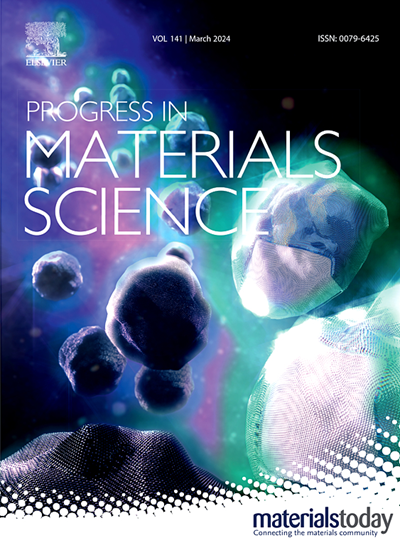Recent progress in electrospun polyvinylidene fluoride (PVDF)-based nanofibers for sustainable energy and environmental applications
IF 33.6
1区 材料科学
Q1 MATERIALS SCIENCE, MULTIDISCIPLINARY
引用次数: 0
Abstract
Clean energy, water, and air are all critical to the sustainable development of humanity. Electrospun nanofibers, including nanofibrous membranes, have attracted enormous interest for energy and environmental applications, whether for energy generation and storage, or separation and purification. Electrospun polyvinylidene difluoride (PVDF)-based nanofibers, in particular, have been extensively studied for various applications (e.g., separation membranes) due to their excellent thermal and chemical stabilities, superior mechanical strength, and excellent processability. In this review, we initially explore PVDF as a preferred material for nanofiber fabrication via electrospinning, highlighting its unique chemistry. Subsequently, we discuss common electrospinning techniques, structures, and the functionality of the resultant nanofibers. As electrospun nanofibers often exhibit relatively open structures with large pores and high porosity, requiring further modification, we consolidate and analyze several pivotal modification methods for electrospun nanofibers, including crosslinking, surface coating, and assembly. We also explore the applications of electrospun PVDF-based nanofibers for clean energy and sustainable environment, including energy harvesting and storage, self-powered sensors, water treatment through different membrane processes, gas separation, and environmental sensing. Finally, we discuss the prospects of electrospun PVDF-based nanofibers for clean energy and sustainable environment. This review provides important guidance on developing desirable electrospun PVDF-based nanofibers and harnessing their capabilities to achieve a sustainable future characterized by clean energy, clean water, and clean air.
用于可持续能源和环境应用的电纺聚偏氟乙烯(PVDF)基纳米纤维的最新进展
清洁的能源、水和空气对人类的可持续发展至关重要。电纺纳米纤维(包括纳米纤维膜)在能源和环境领域的应用引起了人们的极大兴趣,无论是用于能源生产和储存,还是用于分离和净化。尤其是基于聚偏二氟乙烯(PVDF)的电纺纳米纤维,由于其优异的热稳定性和化学稳定性、超强的机械强度和出色的加工性能,在各种应用领域(如分离膜)都得到了广泛的研究。在本综述中,我们首先探讨了 PVDF 作为通过电纺丝制造纳米纤维的首选材料,重点介绍了其独特的化学性质。随后,我们将讨论常见的电纺丝技术、结构以及由此产生的纳米纤维的功能性。由于电纺纳米纤维通常表现出具有大孔和高孔隙率的相对开放结构,需要进一步改性,因此我们综合分析了电纺纳米纤维的几种关键改性方法,包括交联、表面涂层和组装。我们还探讨了基于 PVDF 的电纺纳米纤维在清洁能源和可持续环境方面的应用,包括能量收集和存储、自供电传感器、通过不同膜过程进行水处理、气体分离和环境传感。最后,我们讨论了电纺 PVDF 基纳米纤维在清洁能源和可持续环境领域的应用前景。本综述为开发理想的电纺 PVDF 基纳米纤维和利用其能力实现以清洁能源、清洁水和清洁空气为特征的可持续未来提供了重要指导。
本文章由计算机程序翻译,如有差异,请以英文原文为准。
求助全文
约1分钟内获得全文
求助全文
来源期刊

Progress in Materials Science
工程技术-材料科学:综合
CiteScore
59.60
自引率
0.80%
发文量
101
审稿时长
11.4 months
期刊介绍:
Progress in Materials Science is a journal that publishes authoritative and critical reviews of recent advances in the science of materials. The focus of the journal is on the fundamental aspects of materials science, particularly those concerning microstructure and nanostructure and their relationship to properties. Emphasis is also placed on the thermodynamics, kinetics, mechanisms, and modeling of processes within materials, as well as the understanding of material properties in engineering and other applications.
The journal welcomes reviews from authors who are active leaders in the field of materials science and have a strong scientific track record. Materials of interest include metallic, ceramic, polymeric, biological, medical, and composite materials in all forms.
Manuscripts submitted to Progress in Materials Science are generally longer than those found in other research journals. While the focus is on invited reviews, interested authors may submit a proposal for consideration. Non-invited manuscripts are required to be preceded by the submission of a proposal. Authors publishing in Progress in Materials Science have the option to publish their research via subscription or open access. Open access publication requires the author or research funder to meet a publication fee (APC).
Abstracting and indexing services for Progress in Materials Science include Current Contents, Science Citation Index Expanded, Materials Science Citation Index, Chemical Abstracts, Engineering Index, INSPEC, and Scopus.
 求助内容:
求助内容: 应助结果提醒方式:
应助结果提醒方式:


